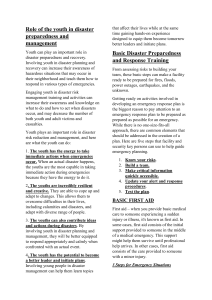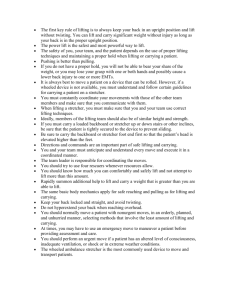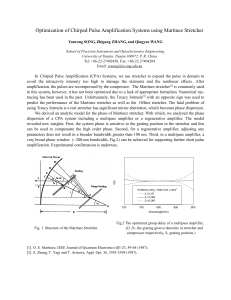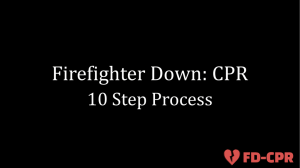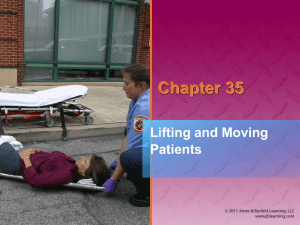Lifting and Moving Patients
advertisement
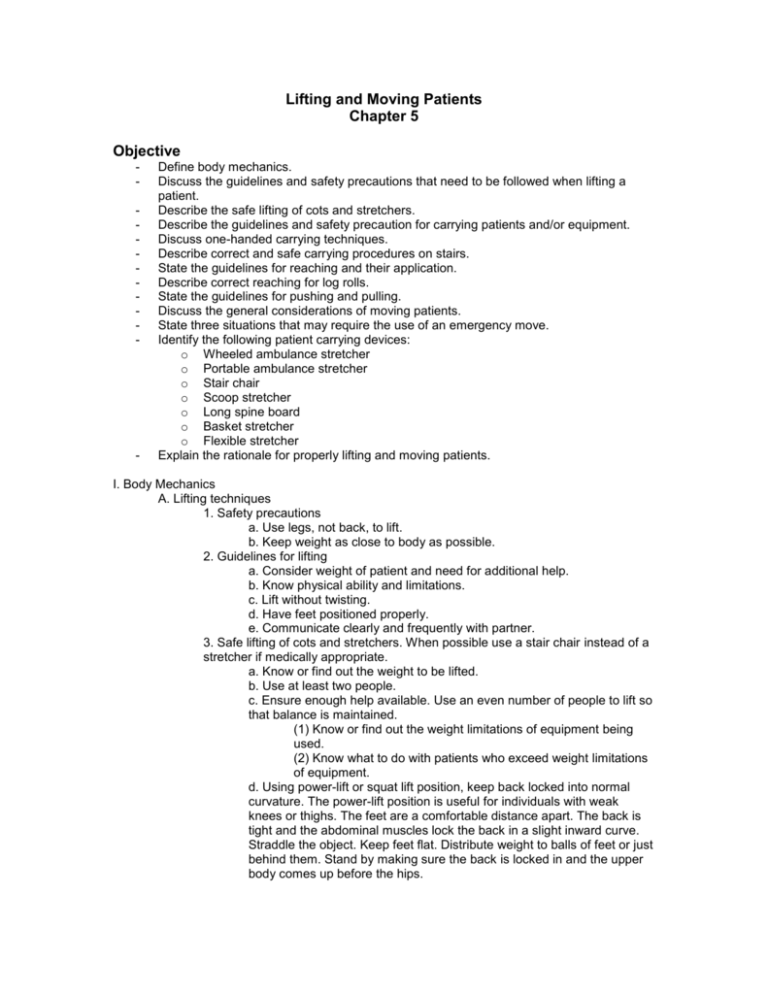
Lifting and Moving Patients Chapter 5 Objective - - Define body mechanics. Discuss the guidelines and safety precautions that need to be followed when lifting a patient. Describe the safe lifting of cots and stretchers. Describe the guidelines and safety precaution for carrying patients and/or equipment. Discuss one-handed carrying techniques. Describe correct and safe carrying procedures on stairs. State the guidelines for reaching and their application. Describe correct reaching for log rolls. State the guidelines for pushing and pulling. Discuss the general considerations of moving patients. State three situations that may require the use of an emergency move. Identify the following patient carrying devices: o Wheeled ambulance stretcher o Portable ambulance stretcher o Stair chair o Scoop stretcher o Long spine board o Basket stretcher o Flexible stretcher Explain the rationale for properly lifting and moving patients. I. Body Mechanics A. Lifting techniques 1. Safety precautions a. Use legs, not back, to lift. b. Keep weight as close to body as possible. 2. Guidelines for lifting a. Consider weight of patient and need for additional help. b. Know physical ability and limitations. c. Lift without twisting. d. Have feet positioned properly. e. Communicate clearly and frequently with partner. 3. Safe lifting of cots and stretchers. When possible use a stair chair instead of a stretcher if medically appropriate. a. Know or find out the weight to be lifted. b. Use at least two people. c. Ensure enough help available. Use an even number of people to lift so that balance is maintained. (1) Know or find out the weight limitations of equipment being used. (2) Know what to do with patients who exceed weight limitations of equipment. d. Using power-lift or squat lift position, keep back locked into normal curvature. The power-lift position is useful for individuals with weak knees or thighs. The feet are a comfortable distance apart. The back is tight and the abdominal muscles lock the back in a slight inward curve. Straddle the object. Keep feet flat. Distribute weight to balls of feet or just behind them. Stand by making sure the back is locked in and the upper body comes up before the hips. e. Use power grip to get maximum force from hands. The palm and fingers come into complete contact with the object and all fingers are bent at the same angles. The power-grip should always be used in lifting. This allows for maximum force to be developed. Hands should be at least 10 inches apart. f. Lift while keeping back in locked-in position. g. When lowering cot or stretcher, reverse steps. h. Avoid bending at the waist. B. Carrying 1. Precautions for carrying - whenever possible, transport patients on devices that can be rolled. 2. Guidelines for carrying a. Know or find out the weight to be lifted. b. Know limitations of the crew's abilities. c. Work in a coordinated manner and communicate with partners. d. Keep the weight as close to the body as possible. e. Keep back in a locked-in position and refrain from twisting. f. Flex at the hips, not the waist; bend at the knees. g. Do not hyperextend the back (do not lean back from the waist). 3. Correct carrying procedure a. Use correct lifting techniques to lift the stretcher. b. Partners should have similar strength and height. 4. One-handed carrying technique a. Pick up and carry with the back in the locked-in position. b. Avoid leaning to either side to compensate for the imbalance. 5. Correct carrying procedure on stairs a. When possible, use a stair chair instead of a stretcher. b. Keep back in locked-in position. c. Flex at the hips, not the waist; bend at the knees. d. Keep weight and arms as close to the body as possible. C. Reaching 1. Guidelines for reaching a. Keep back in locked-in position. b. When reaching overhead, avoid hyperextended position. c. Avoid twisting the back while reaching. 2. Application of reaching techniques a. Avoid reaching more than 15 - 20 inches in front of the body. b. Avoid situations where prolonged (more than a minute) strenuous effort is needed in order to avoid injury. 3. Correct reaching for log rolls a. Keep back straight while leaning over patient. b. Lean from the hips. c. Use shoulder muscles to help with roll. D. Pushing and pulling guidelines 1. Push, rather than pull, whenever possible. 2. Keep back locked-in. 3. Keep line of pull through center of body by bending knees. 4. Keep weight close to the body. 5. Push from the area between the waist and shoulder. 6. If weight is below waist level, use kneeling position. 7. Avoid pushing or pulling from an overhead position if possible. 8. Keep elbows bent with arms close to the sides. II. Principles of Moving Patients A. General considerations 1. In general, a patient should be moved immediately (emergency move) only when: a. There is an immediate danger to the patient if not moved. (1) Fire or danger of fire. (2) Explosives or other hazardous materials. (3) Inability to protect the patient from other hazards at the scene. (4) Inability to gain access to other patients in a vehicle who need life-saving care. b. Life-saving care cannot be given because of the patient's location or position, e.g., a cardiac arrest patient sitting in a chair or lying on a bed. 2. A patient should be moved quickly (urgent move) when there is immediate threat to life. a. Altered mental status b. Inadequate breathing c. Shock (hypoperfusion) 3. If there is no threat to life, the patient should be moved when ready for transportation (non-urgent move). B. Emergency moves 1. The greatest danger in moving a patient quickly is the possibility of aggravating a spine injury. 2. In an emergency, every effort should be made to pull the patient in the direction of the long axis of the body to provide as much protection to the spine as possible. 3. It is impossible to remove a patient from a vehicle quickly and at the same time provide as much protection to the spine as can be accomplished with an interim immobilization device. 4. If the patient is on the floor or ground, he can be moved by: a. Pulling on the patient's clothing in the neck and shoulder area. b. Putting the patient on a blanket and dragging the blanket. c. Putting the EMT-Basic's hands under the patient's armpits(from the back), grasping the patient's forearms and dragging the patient. C. Urgent moves 1. Rapid extrication of patient sitting in vehicle a. One EMT-Basic gets behind patient and brings cervical spine into neutral in-line position and provides manual immobilization. b. A second EMT-Basic applies cervical immobilization device as the third EMT-Basic first places long backboard near the door and then moves to the passenger seat. c. The second EMT-Basic supports the thorax as the third EMT-Basic frees the patient's legs from the pedals. d. At the direction of the second EMT-Basic, he and the third EMT-Basic rotate the patient in several short, coordinated moves until the patient's back is in the open doorway and his feet are on the passenger seat. e. Since the first EMT-Basic usually cannot support the patient's head any longer, another available EMT-Basic or a bystander supports the patient's head as the first EMT-Basic gets out of the vehicle and takes support of the head outside of the vehicle. f. The end of the long backboard is placed on the seat next to the patient's buttocks. Assistants support the other end of the board as the first EMT-Basic and the second EMT-Basic lower the patient onto it. g. The second EMT-Basic and the third EMT-Basic slide the patient into the proper position on the board in short, coordinated moves. h. Several variations of the technique are possible, including assistance from bystanders. Must be accomplished without compromise to the spine. D. Non-urgent moves 1. Direct ground lift (no suspected spine injury) a. Two or three rescuers line up on one side of the patient. b. Rescuers kneel on one knee (preferably the same for all rescuers). c. The patient's arms are placed on his chest if possible. d. The rescuer at the head places one arm under the patient's neck and shoulder and cradles the patient's head. He places his other arm under the patient's lower back. e. The second rescuer places one arm under the patient's knees and one arm above the buttocks. f. If a third rescuer is available, he should place both arms under the waist and the other two rescuers slide their arms either up to the midback or down to the buttocks as appropriate. g. On signal, the rescuers lift the patient to their knees and roll the patient in toward their chests. h. On signal, the rescuers stand and move the patient to the stretcher. i. To lower the patient, the steps are reversed. 2. Extremity lift (no suspected extremity injuries) a. One rescuer kneels at the patient's head and one kneels at the patient's side by his knees. b. The rescuer at the head places one hand under each of the patient's shoulders while the rescuer at the foot grasps the patient's wrists. c. The rescuer at the head slips his hands under the patient's arms and grasps the patient's wrists. d. The rescuer at the patient's foot slips his hands under the patient's knees. e. Both rescuers move up to a crouching position. f. The rescuers stand up simultaneously and move with the patient to a stretcher. 3. Transfer of supine patient from bed to stretcher a. Direct carry (1) Position cot perpendicular to bed with head end of cot at foot of bed. (2) Prepare cot by unbuckling straps and removing other items. (3) Both rescuers stand between bed and stretcher, facing patient. (4) First rescuer slides arm under patient's neck and cups patient's shoulder. (5) Second rescuer slides hand under hip and lifts slightly. (6) First rescuer slides other arm under patient's back. (7) Second rescuer places arms underneath hips and calves. (8) Rescuers slide patient to edge of bed. (9) Patient is lifted/curled toward the rescuers' chests. (10) Rescuers rotate and place patient gently onto cot. b. Draw sheet method (1) Loosen bottom sheet of bed. (2) Position cot next to bed. (3) Prepare cot: Adjust height, lower rails, unbuckle straps. (4) Reach across cot and grasp sheet firmly at patient's head, chest, hips and knees. (5) Slide patient gently onto cot. III. Equipment A. Stretchers/cots 1. Types a. Wheeled stretcher (1) Most commonly used device (2) Rolling (a) Restricted to smooth terrain. (b) Foot end should be pulled. (c) One person must guide the stretcher at head. (3) Carrying (a) Two rescuers i) Preferable in narrow spaces, but requires more strength. ii) Easily unbalanced. iii) Rescuers should face each other from opposite ends of stretcher. (b) Four rescuers i) One rescuer at each corner. ii) More stability and requires less strength. iii) Safer over rough terrain. (4) Loading into ambulance (a) Use sufficient lifting power. (b) Load hanging stretchers before wheeled stretchers. (c) Follow manufacturer's directions. (d) Ensure all cots and patients secured before moving ambulance. b. Portable stretcher c. Stair chair d. Backboards (1) Long (a) Traditional wooden device (b) Manufactured varieties (2) Short (a) Traditional wooden device (b) Vest type device e. Scoop or orthopedic stretcher f. Flexible stretcher 2. Maintenance - follow manufacturer's directions for inspection, cleaning, repair and upkeep. B. Patient positioning 1. An unresponsive patient without suspected spine injury should be moved into the recovery position by rolling the patient onto his side (preferably the left) without twisting the body. 2. A patient with chest pain or discomfort or difficulty breathing should sit in a position of comfort as long as hypotension is not present. 3. A patient with suspected spine injury should be immobilized on a long backboard. 4. A patient in shock (hypoperfusion) should have his legs elevated 8 - 12 inches. 5. For the pregnant patient with hypotension, an early intervention is to position the patient on her left side. 6. A patient who is nauseated or vomiting should be transported in a position of comfort; however, the EMT-Basic should be positioned appropriately to manage the airway.
